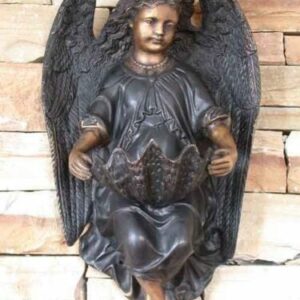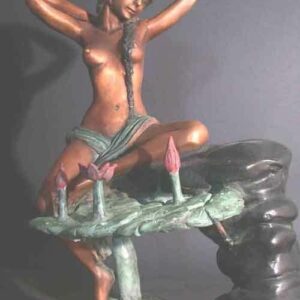Description
When ordering from the United States, packages may be subject to import taxes and duties, which the buyer is responsible for paying.
” Gone Fishin ” Real Bronze Koi Fish Pond Ornament Not a Style Funny
Hidden Art Treasure from “eBronzeMart”
“Gone Fishing”
Real bronze
Lost wax casting process
This will touch the hearts of many a man thinking back to a previous day.
My father tells stories of his childhood fishing from the shore and too I can remember this exact same position;
carefully stroking out on a log of the waters edge, trying to save a catch that got tangled in the roots of the tree.
These were happy days with little else to think about.
This bronze sculpture will transform your pond into something magical!
Guaranteed to awaken memories of those perfect days at the lake fishing a river bank.
26″ Long x 16 1/2″ tall x 11″ wide .
18 lbs .

HOW IS IT MADE?
The “Lost Wax” process
What gives bronze art value beyond that of a “souvenir” that ends up in a closet? There are many reasons, including the cost of materials (bronze, silicone molds, tools, kilns, etc.) The main reason is that there are very few people trained in the tedious process practiced by the ancient Greeks and Romans. Bronze sculpture is not easy to do and involves many time consuming, difficult steps. In a hi-tech world of mass production, bronze casting remains largely unchanged. Beware of “cold cast” or “bonded bronze”, these are misleading names given to plastic figurines. Each of our genuine bronze castings is actually an “original” and the following explains why. These are the basic steps involved in creating a bronze sculpture using the classic “cire perdue” (wax loss) process:
• artist’s original model • silicone mold of model • create lost-wax mold • bronze casting • clean casting mold • grind, rasp, and file bronze • assemble pieces by soldering • file and finish assembled piece • polish • apply patina
All bronze pieces are cast from a wax model regardless of the original material the model was sculpted from. A silicone mold is made from the artist’s finished piece, and a hollow wax cast is drawn from this mold. The wax is repaired, re-worked, and finished to the sculptor’s specifications. Before creating a ceramic shell (explained below), vents are attached to the inside of the wax model. These vents are necessary in difficult areas where gases can accumulate such as the hips, limbs, and neck. The vents will allow gases to escape when the molten bronze is poured and will help prevent air pockets from forming and exploding the ceramic shell. The ceramic shell is one of the few materials the can withstand the heat of the molten metal.
Once the wax cast has hardened and the vents are in place a ceramic shell is formed over the wax. This shell is made by dipping the wax into a slurry, covering it with sand, drying it and repeating the process up to 14 times. A core consisting of plaster, earth bricks and water is poured into the wax mold. After the ceramic shell and core are set, the mold is fired in a kiln, the wax is melted and the ceramic shell is left untouched. This process is known in French as “cire perdue” (lost wax). Molten bronze is now poured into the cavity left by the molten wax. When the bronze has cooled, the shell is chipped away with a hammer and chisel.
The bronze must now be repaired and finished. This step is called “chasing” and is a difficult process because metal is involved. Any imperfections such as air pockets in the wells will need to be brazed with bronze rod, as in welding. All joints and spurs must be removed by grinding, squeezing and finally sanding. The next step is to chase or hammer the air pockets out of the mold using special tools. Natural bronze has a matte finish. After finishing, a final patina is applied which can be left dull or shiny. Chemicals, pigments, heat, safety equipment and a lot of experience are involved. Also, because bronze comes in a variety of alloys, patina requires different techniques and chemicals.
800-321-8618 for credit cards or if you have questions.

| Country/Region of Manufacture | United States |






Reviews
There are no reviews yet.